ASUS G74SX: Noteworthy Updates to ASUS' G7 Series
by Jarred Walton on October 6, 2011 12:00 AM ESTSystem Temperatures and Noise Levels
One area where I’ve praised the ASUS G73 in the past is their thermals and noise levels. The G74SX continues that reputation, providing an extremely quiet notebook even during lengthy gaming sessions. Idle noise levels fail to register above the ~30dB noise floor of my testing equipment and environment, and under maximum load the G74SX still only hits 37.3dB. Of course, noise is only half the equation—is ASUS just running their fans at low RPMs to keep things quiet while letting the internal components roast? Here’s a chart showing maximum temperatures as reported by HWMonitor after several hours of running high load tasks (Cinebench, x264 encoding, gaming, 3DMark looping, and even 3DMark looping while Cinebench renders in the background).
Compared to the noise created by Clevo gaming notebooks and other offerings like MSI’s GT680R, the ASUS G7 series delivers the goods in cooling and keeping quiet. In our stress testing, the CPU maxed out at a comfortable 76C, while the GTX 560M laughs as it fans itself lightly with a 65C core temperature. That makes the CPU temperatures roughly the same as the G73, while GPU temperatures have dropped 10C—apparently the reworking of the internals paid off handsomely.
I do have a concern over whether the G74SX can handle extreme environments—like say a soldier wants to pack one of these over to the Middle East during the summer months. To see if the fan speeds normally experienced are the maximum ASUS supports or if the system just isn’t getting hot enough to ramp up the RPMs, I put my hand over the rear vent while running 3DMark06. Naturally, temperatures started to climb, but unfortunately I can’t say the same for the fan RPMs. Noise levels remained consistent throughout the approximately 10 minute test run, and the GPU did manage to get up to 75C according to HWMonitor. That’s still 8C below what Dustin measured on the Alienware M18x, but it was painfully hot on my arm/hand. (Honestly, I’m surprised the GPU and CPU didn’t get any hotter!) The final score also dropped slightly (to 15241), but I’m not sure if that was a decrease caused by heat or if the new (beta) drivers are to blame.
While the above scenario may not be a fair test, I do wish ASUS had at least one higher fan speed available, and with a maximum load of Cinebench + 3DMark06 there did appear to be some throttling going on—again, though, only when I covered the exhaust vent, which isn’t something I’d recommend doing. The lack of a higher (and noisier) fan speed may also be why ASUS limits the G74SX to the GTX 560M. The GTX 570M and GTX 580M would likely need better cooling, and ASUS may not be willing to sacrifice noise levels in order to support such GPUs.
Update: A reader pointed out a potential CPU throttling issue in the comments, and I was able to replicate the throttling. The throttling so far required the use of Furmark along with a heavily threaded CPU workload, at which point the CPU clock drops to 800MHz and stays there until Furmark is halted (or the CPU load is removed). The temperatures are not a problem, and without using Furmark I have not been able to cause CPU throttling, but the potential is at least there. If anyone has other specific workloads not involving Furmarm (or a similar utility, e.g. MSI Kombustor), please let me know and I will investigate further.
Still a Good LCD
The G73 notebook had a good LCD, with a high contrast and reasonable color. My one complaint was that even at maximum intensity, the backlight wasn’t as bright as I would like. With the G74SX, ASUS appears to have taken that criticism to heart, as the maximum brightness is nearly double that of its predecessor.
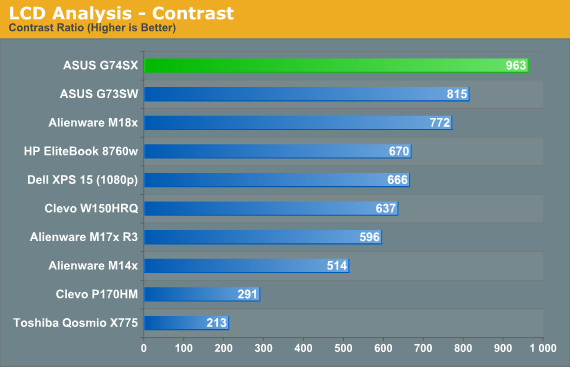
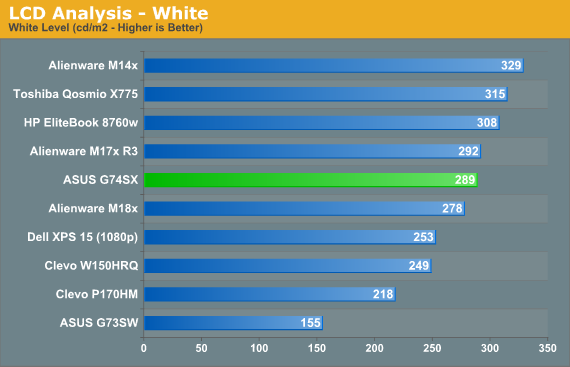
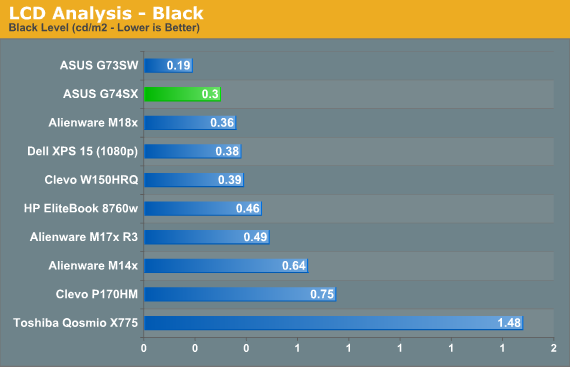
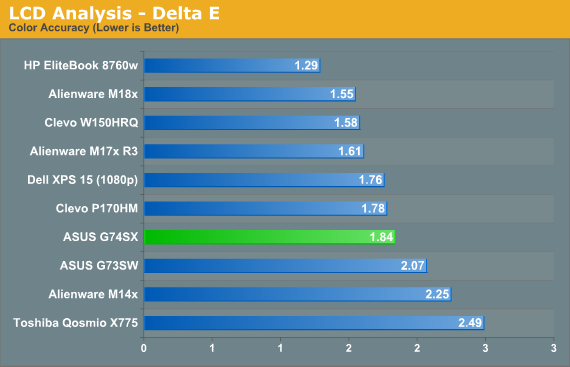
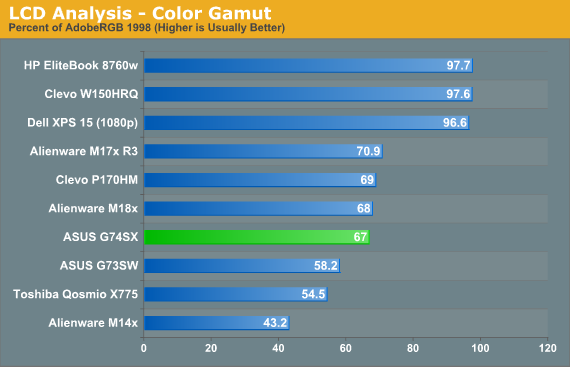
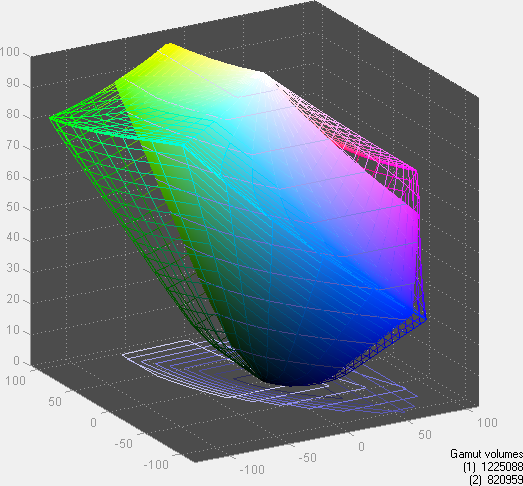
Contrast is excellent at nearly 1000:1, and the maximum white level of 289 nits is a big step up from the ~150 nits of the G73 series. Given the change in characteristics, it’s no surprise that the LCD panel used in the G74SX is different this round, coming from Chimei Innolux (instead of HannStar). The model is N173HGE-L21, and it appears that our contrast ratio result is better than the advertised 500:1. Backlight intensity is up, and we also note that color gamut is up, with a slight (not generally noticeable) improvement in color accuracy as well. Without calibration, the panel has a decidedly bluish cast, but that’s common among LED backlit panels. Overall, I definitely appreciate the changes made to the LCD panel; the previous version was good, but the new version matches or improves on it in virtually every way.
We’re still dealing with a TN panel, so viewing angles aren’t perfect, but they’re about as good as you can expect from the technology. I still wish the notebook people would start using IPS panels in laptops—they’re putting them in $400 tablets after all, so it can’t be that hard to fit one into the budget of a $1500+ notebook, can it? Then again, supply and demand create a self-perpetuating cycle, so as demand dries up so does supply, resulting in higher prices for the remaining supply, which segues back into lowered demand, etc. I’d love to see that trend reverse and go the other way.


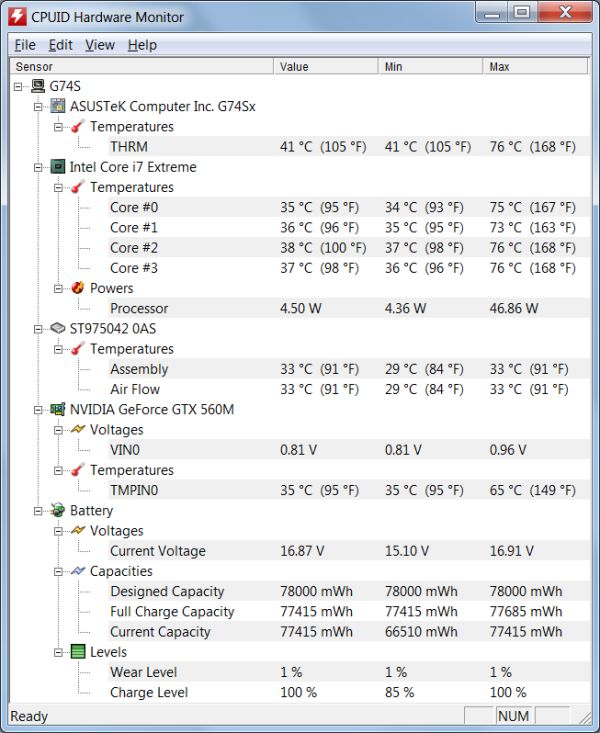













44 Comments
View All Comments
plonkplink - Thursday, October 6, 2011 - link
I'll just skip this review since:1. it has a squinty letterbox screen (16:9).
2. it's an octodecillion times uglier than the saxxy Toshiba Qosmio.
3. Just as someone said: "beep blueray;that is all.". :)
Dustin Sklavos - Thursday, October 6, 2011 - link
2 and 3 are reasonable enough...1, though. Yeah...good luck with that. The industry made the shift. None of us are happy about it, but we can either sit in the corner and sulk about the lost 120 pixels of vertical real estate or be happy that mobile graphics are fast enough to drive the rest of it.
JojoKracko - Thursday, October 6, 2011 - link
I have to agree with 1. By going to a 17 inch laptop, you've already decided to accept a larger size / heavier / more expensive laptop so that negates all of the manufacturer's flimsy excuses for using a 16x9 display over a 16x10 version. Total BS IMHO how the industry got away with screwing everyone with this aspect ratio change. 16x10 is better for every single use on your computer - except one - watching movies. And really, how many of you would prefer to watch a movie on your laptop instead of on your widescreen TV?2. I personally prefer the G74. Call me crazy. Better textures.
3. As I would watch movies on my TV, I agree. Beep Blueray!
I'd add 4. Beep more than 8 GB of ram on laptops and more than 1.5 GB on the video cards in general. Useless, wasteful marketing gimmicks. Lower the price by the same amount instead. It is already crazy how fast a 2 grand laptop loses its value.
5. Matte AR Screen for fricks sake ASUS!!!!!
6. MATTE SCREEN - it is worth repeating until they realize they could take ALL of MSI's business with this one change.
seapeople - Friday, October 7, 2011 - link
Stop saying this.1920x1200 is better than 1920x1080 because it has more pixels, not because of the aspect ratio.
I actually prefer more screen width than height... I always run into problems with width when I'm trying to look at multiple applications on the screen at once rather than height.
If you're really going to argue that it's the aspect ratio, then tell me what you would like better: 1600x900 or 1440x900?
erple2 - Sunday, October 9, 2011 - link
Until applications become more horizontally focused, the more vertical pixels become important.It's not that I prefer 1440x900 over 1600x900, it's for a given number of horizontal pixels, I'd MUCH rather have more vertical pixels - so I'd prefer 1600x1000 over 1600x900 every time.
As long as the menubars, tabs, close buttons etc are all aligned vertically, I'll still say that I want more vertical pixels for a given horizontal pixel count.
I wouldn't mind having a 2133x1200 res screen (16x9 with 1200 vertical pixels), but nobody makes them.
Even on my 1080p laptop, I feel as though it's vertically cramped. Then again, I'm used to using 1920x1200 screens on my desktop for work and play.
Wolfpup - Friday, October 7, 2011 - link
16:9 is today's normal aspect ratio, and it's not "squinty", the resolution and screen size work pretty well for a notebook."Ugly" is subjective, but I like the G74's utilitarianness. I find Toshiba and Dell's systems much uglier, though that's bottom on my list for why I buy a system regardless.
And I have no idea what "beep blueray" means. At first I thought you thought this didn't have it, which it does. Now I'm thinking you DON'T want it for some unknown reason...well, you don't have to use it, or can buy a cheaper G74 model without it.
JojoKracko - Tuesday, October 11, 2011 - link
Beep Bluray just means that it is unnecessary for most of us. Especially the versions with the bluray burner. Realistically, how many buyers of the G74 do so because it has a bluray burner? Half of 1 percent? If that? It is a useless marketing gimmick. Just like moving from 8-16 GB of ram (again, might help 1/2 of 1% of us), or 3GB of video card ram vs 1.5 GB. Even the GTX570M is slower than an old desktop 460GTX and that card can't max out it's 1GB of ram. 3GB is a joke, and 30 bucks that should have been spent on something useful - like a taller screen, better cooling, a bump to the next level of cpu, a bump to the GTX570M, etc. Same goes for the extra $40 for bluray player, or extra $100 for bluray burner. Marketing BS. Doesn't help the majority of you. Demand to be able to pay for what you need.Comment here or even better, write letters to Asus.
Oh, best use of the extra cash? MATTE F'ing SCREENS!!! This reflective crap should have been banned a decade ago.
piroroadkill - Thursday, October 6, 2011 - link
16GB RAM is useless for the vast majority of people.Give me an IPS 1920x1200 screen and 8GB RAM instead, and it would be almost perfect.
piroroadkill - Thursday, October 6, 2011 - link
Perfect.. spec wise, I mean.JojoKracko - Thursday, October 6, 2011 - link
True Dat! 1900 x 1200 IPS panel. Extra $75. Well worth the expense. Heck, double or triple it and I'd still pay it for these two features.MATTE SCREEN also. They did it with their top of the line 3D version and it was far superior to the glossy crap screen you get with this 'update' version - IMHO.